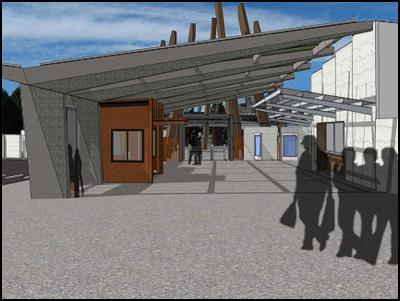Commencement of new entranceway continues Te Puia developme

Artist's impression of the new Te Puia entranceway.
For Immediate
Release
12 July, 2012
Commencement of new entranceway continues Te Puia development
The latest phase in the development of the New Zealand Māori Arts and Crafts Institute, Te Puia, has commenced, with initial groundwork preparation underway for the construction of a new entranceway (waharoa) at the cultural centre’s main entrance.
Te Puia Chief Executive, Tim Cossar, says the new front entrance is a major development for Te Puia, and extends the significant work undertaken in 2006 and 2007 that included the prominent Te Heketanga a Rangi, located immediately inside the front gate.
Mr Cossar says the new entranceway will include a covered canopy for all visitors (manuhiri) to enjoy and this will provide and even better sense of welcome and shelter from the weather on hot or inclement days. The new entrance development also includes a host whare (house/office) for Te Puia guides and front line hosting staff to operate from.
He says the design for the new entranceway combines traditional and contemporary elements, designed to ensure the construction adds value to the surrounding environment and landscape. The design also includes a range of components that are unique to Rotorua and Te Puia’s heritage, incorporating native wood, carvings and glasswork.
"The new development is designed to link seamlessly into the building work undertaken on the site previously. The purpose is to provide a warm, sheltered, welcoming, high quality and dynamic entrance for our manuhiri.
"The new Waharoa means that from the moment manuhiri embark from coaches or park their vehicles, they will be better protected from the elements. Te Puia has been welcoming manuhiri for over 50 years and our commitment to providing them with a warm, welcoming and unique experience from the moment they arrive is as strong as ever."
Mr Cossar says the new development also provides comfortable spaces for Te Puia staff who look after manuhiri in and around the main entrance.
"Our people are the heart of our operation and it's just as important that we look after our staff, as it is that we focus on our manuhiri."
Mr Cossar says a new gate system will also be installed as part of the development.
"The current hand held electronic system will be upgraded toa permanent electronic ticketing gate system, which means that manuhiri entry will be quicker and more efficient."
Mr Cossar says there may be some small disruptions to manuhiri during the redevelopment, mainly around arrival flow and entrance gates at different times in the construction.
"The development will take between 10 and 12 weeks to complete, however, much of the heavy construction will be undertaken outside opening hours to minimise the impact on manuhiri and staff."
Mr Cossar says Te Puia's investment in the development is a reflection of the operation's views that the visitor industry will continue to grow in the years ahead.
"We also see real potential to grow the cultural experience that we have become so well known for.
"We are also pleased to be able to invest in the local Rotorua economy by employing a local company, Burton Construction, to undertake the development."
The New Zealand Māori Arts and Crafts Institute (now known as Te Puia) was established in 1963 by an Act of Parliament to maintain and preserve traditional Māori art forms. The operation includes the world famous Pohutu Geyser, traditional carving and weaving schools, and guided tours that follow in the traditions of Te Arawa guides that have been part of the region for more than 150 years.
ENDS


 NZSEG: Powering The Future - NZSE College And Royal New Zealand Navy Forge Educational Partnership
NZSEG: Powering The Future - NZSE College And Royal New Zealand Navy Forge Educational Partnership Courtney Duncan: Illness Prevents Duncan From Contesting First Round Of 2025 World Women’s Motocross Championship
Courtney Duncan: Illness Prevents Duncan From Contesting First Round Of 2025 World Women’s Motocross Championship GPNZ: Extended Skill Mix In Primary Care Teams Improves Patient Access And Outcomes
GPNZ: Extended Skill Mix In Primary Care Teams Improves Patient Access And Outcomes New Zealand Symphony Orchestra: Music Legend To Conduct Bach, Beethoven And Mozart With NZSO
New Zealand Symphony Orchestra: Music Legend To Conduct Bach, Beethoven And Mozart With NZSO Ministry of Health: Ministry Of Health To Look Further At Waikato Hospital Event
Ministry of Health: Ministry Of Health To Look Further At Waikato Hospital Event Emirates Team NZ: Statement From Emirates Team NZ On Auckland Hosting Of 38th America’s Cup
Emirates Team NZ: Statement From Emirates Team NZ On Auckland Hosting Of 38th America’s Cup